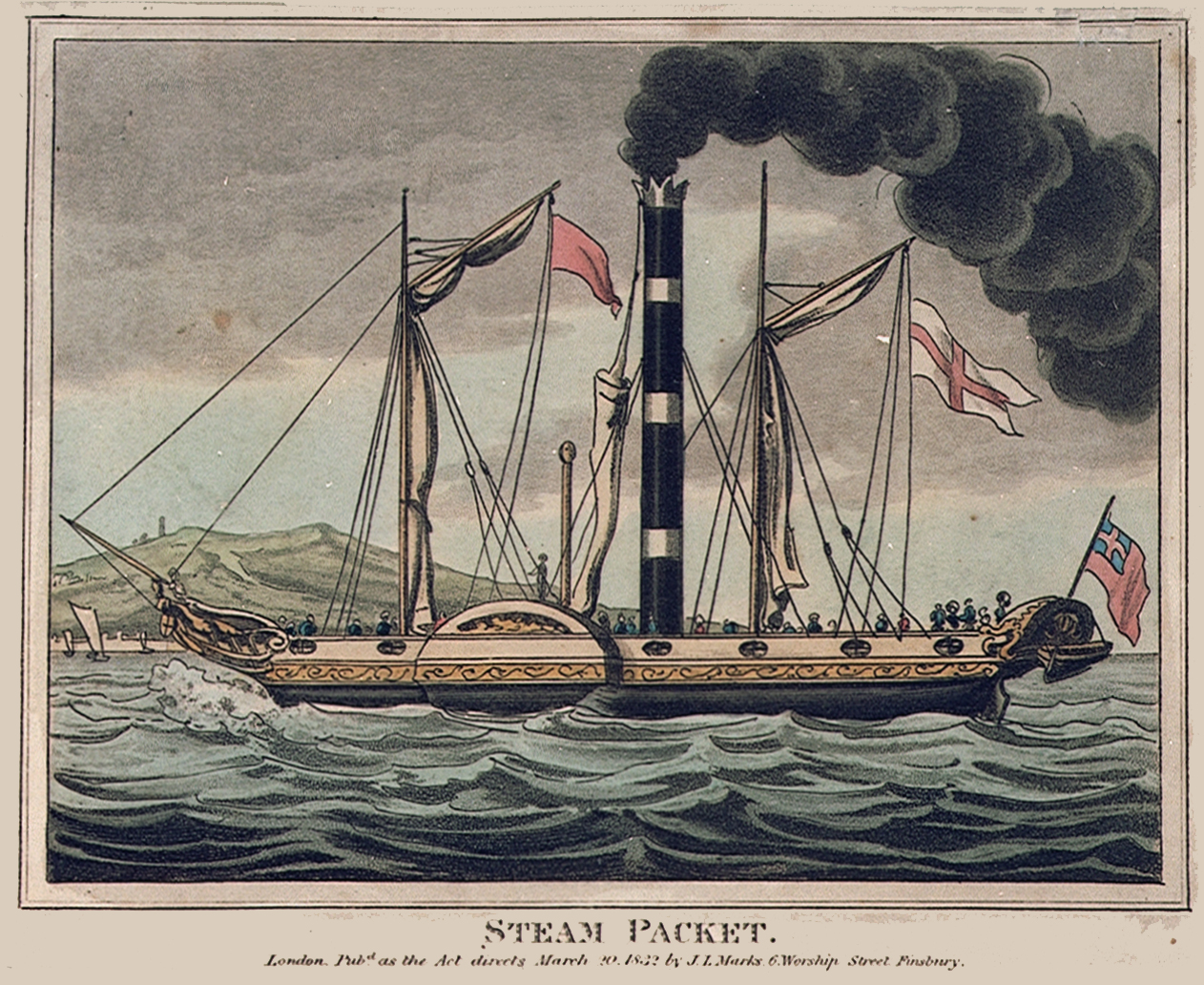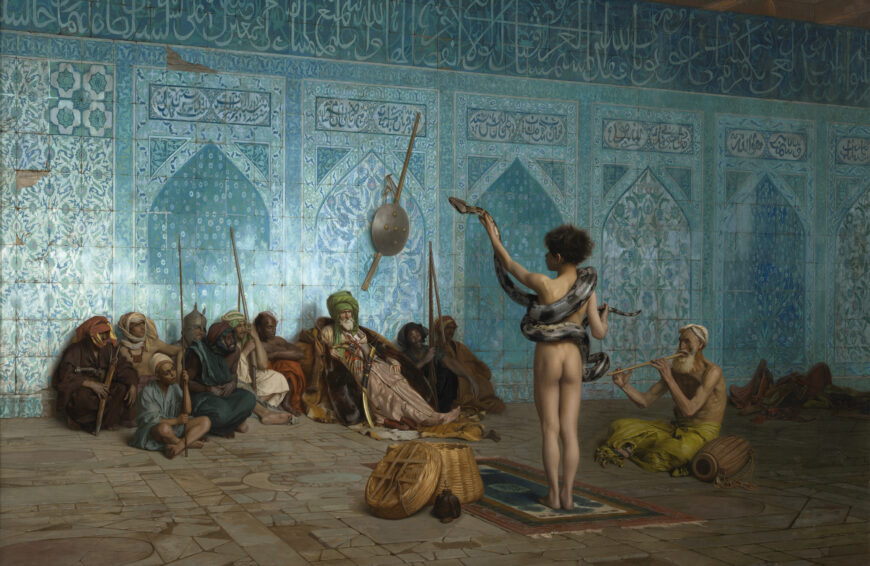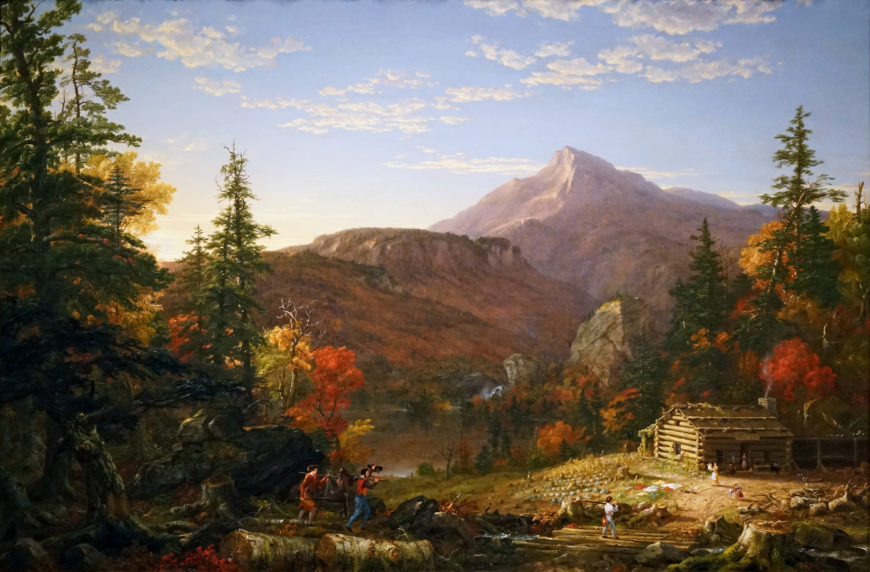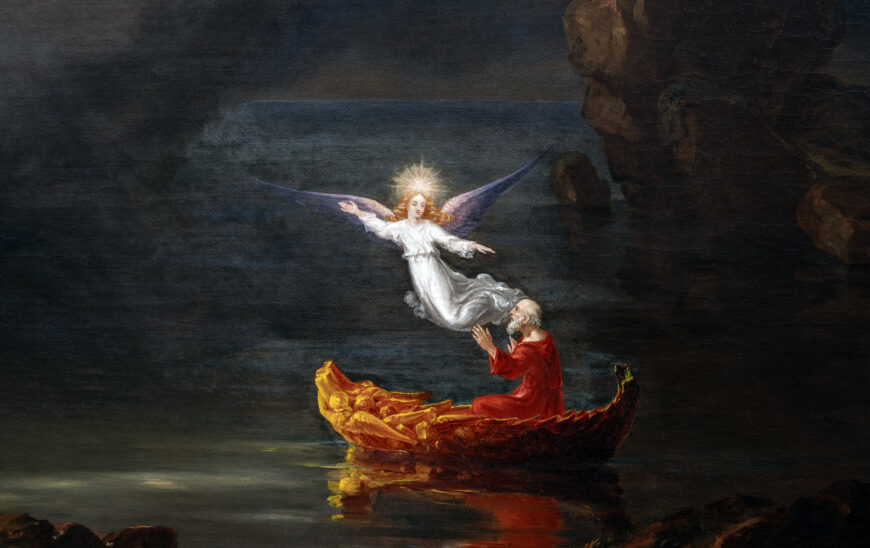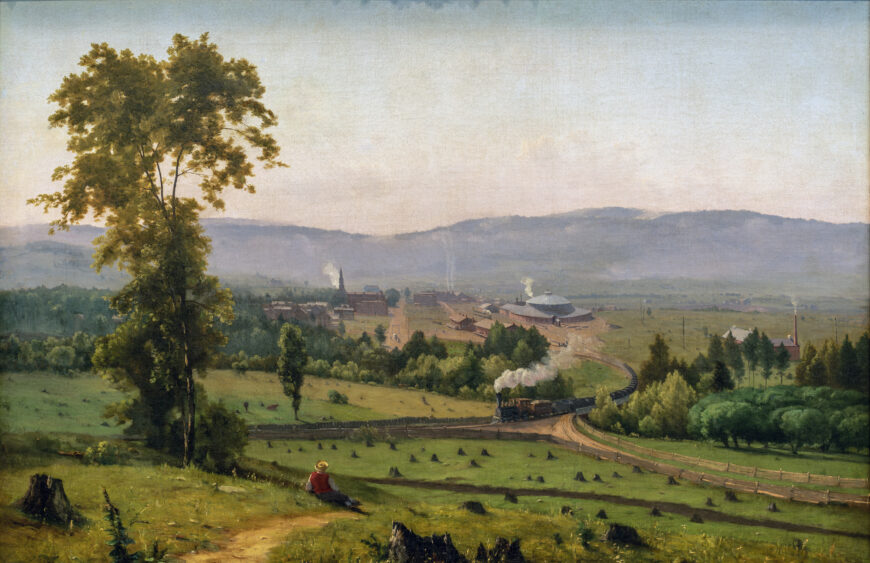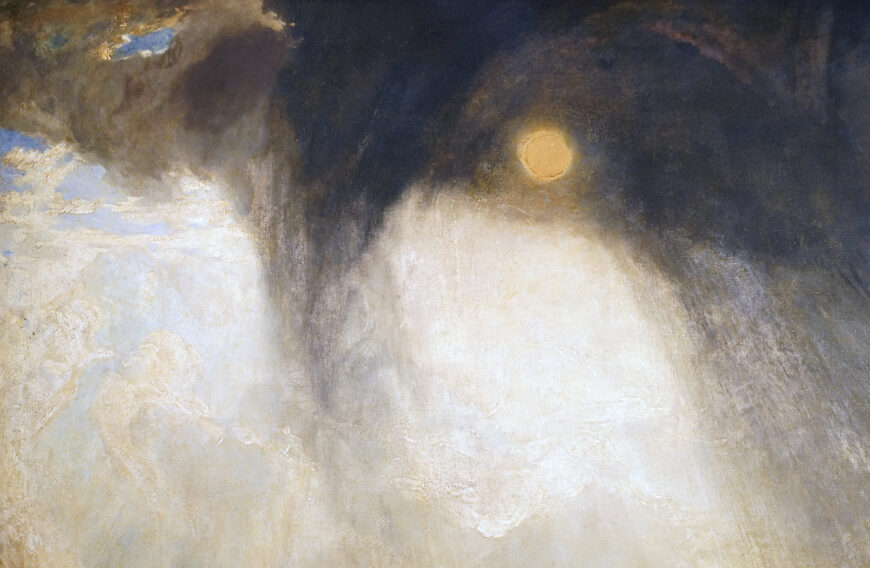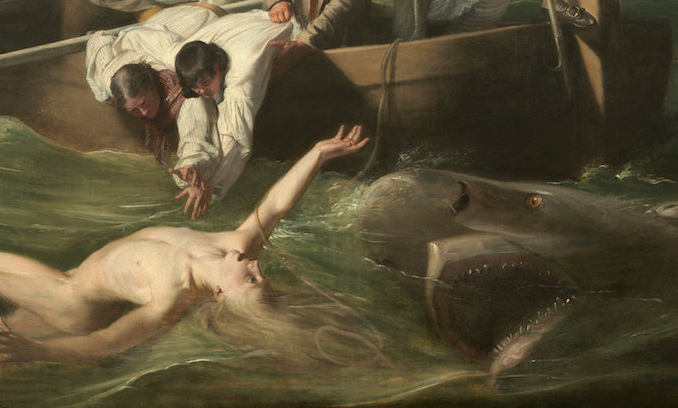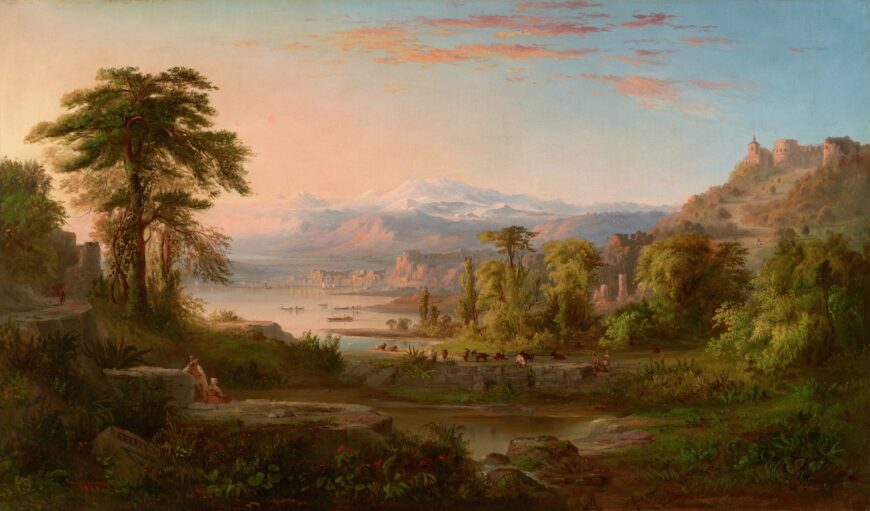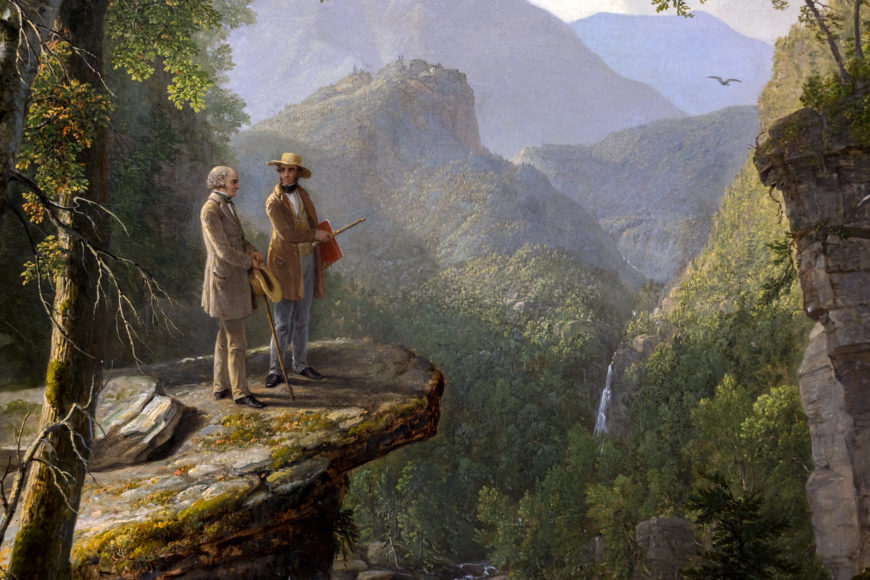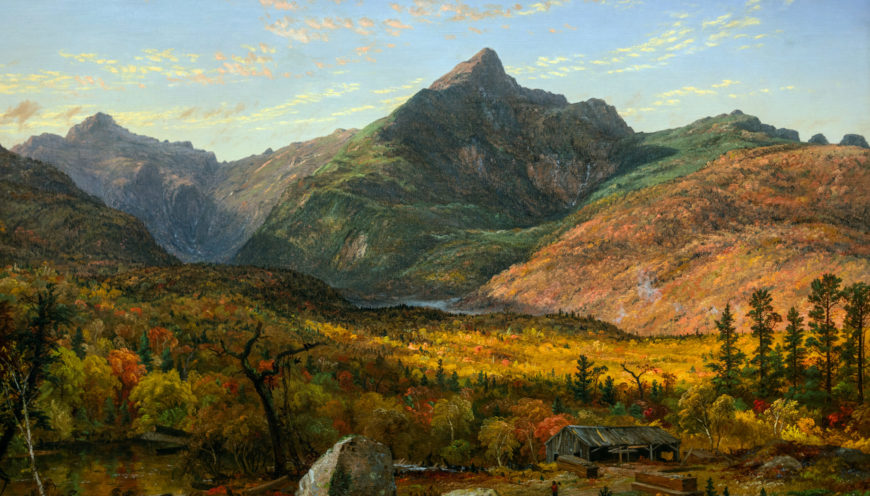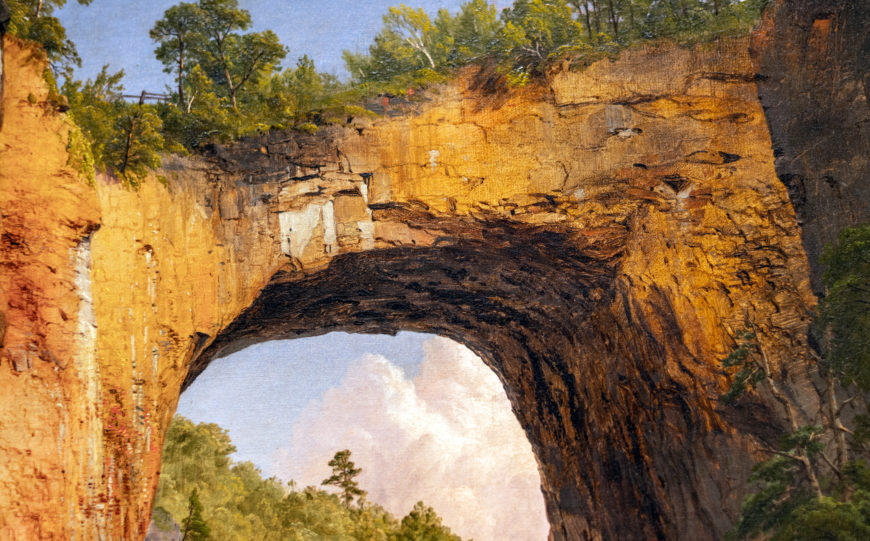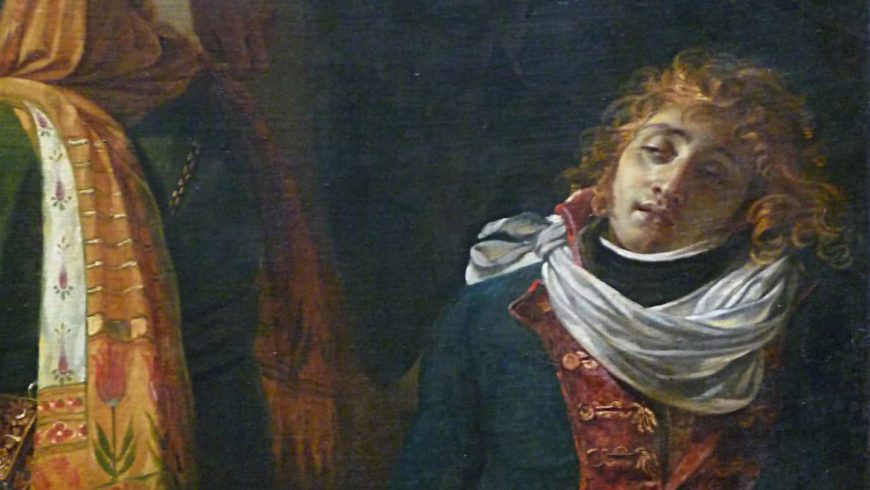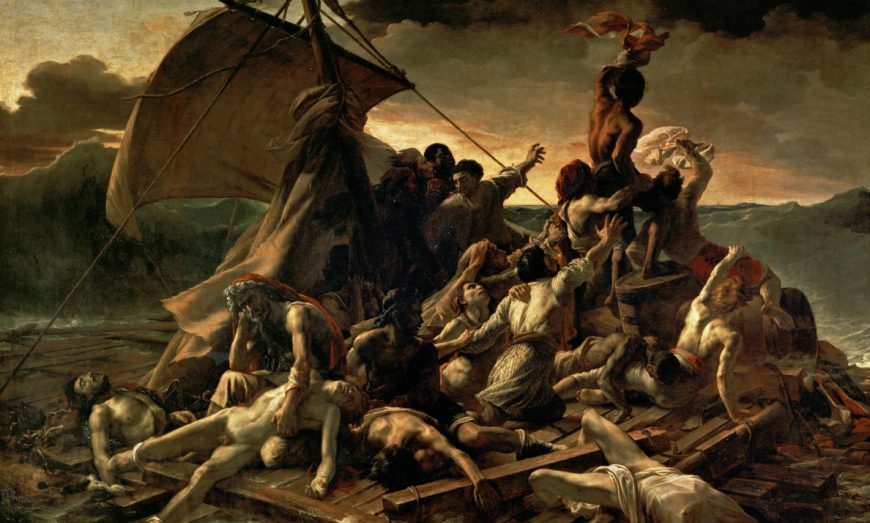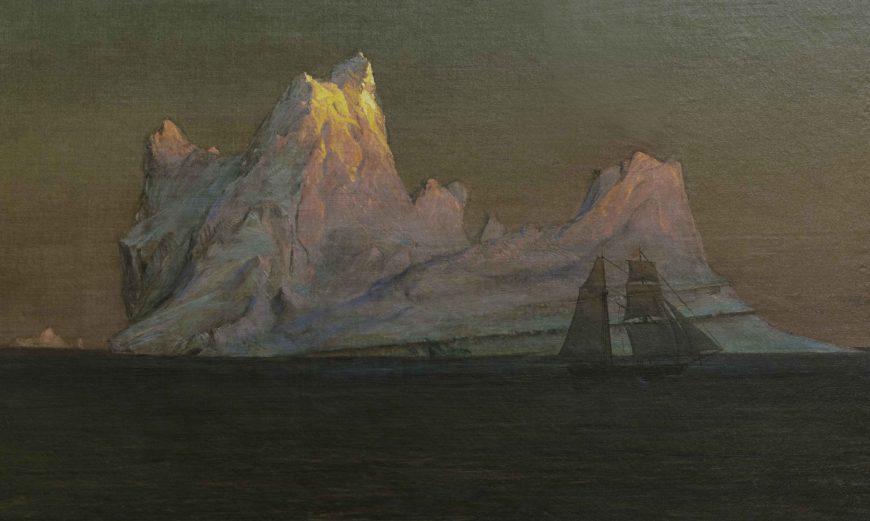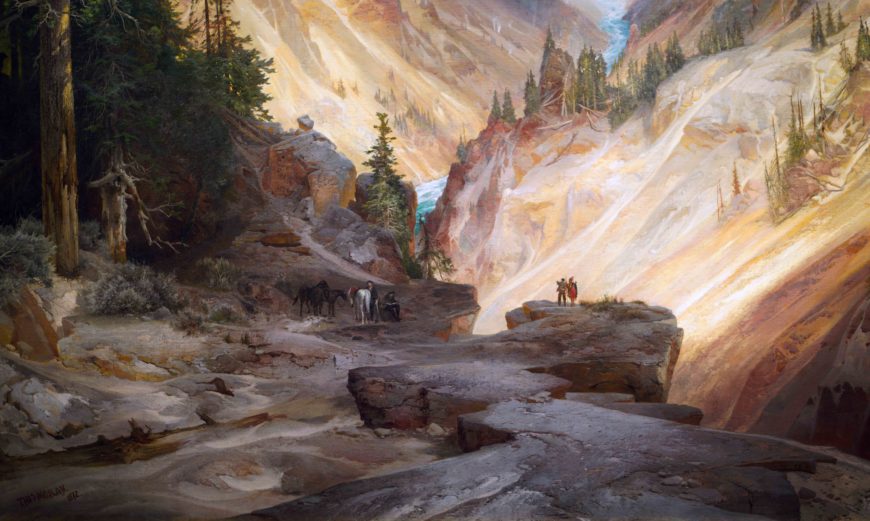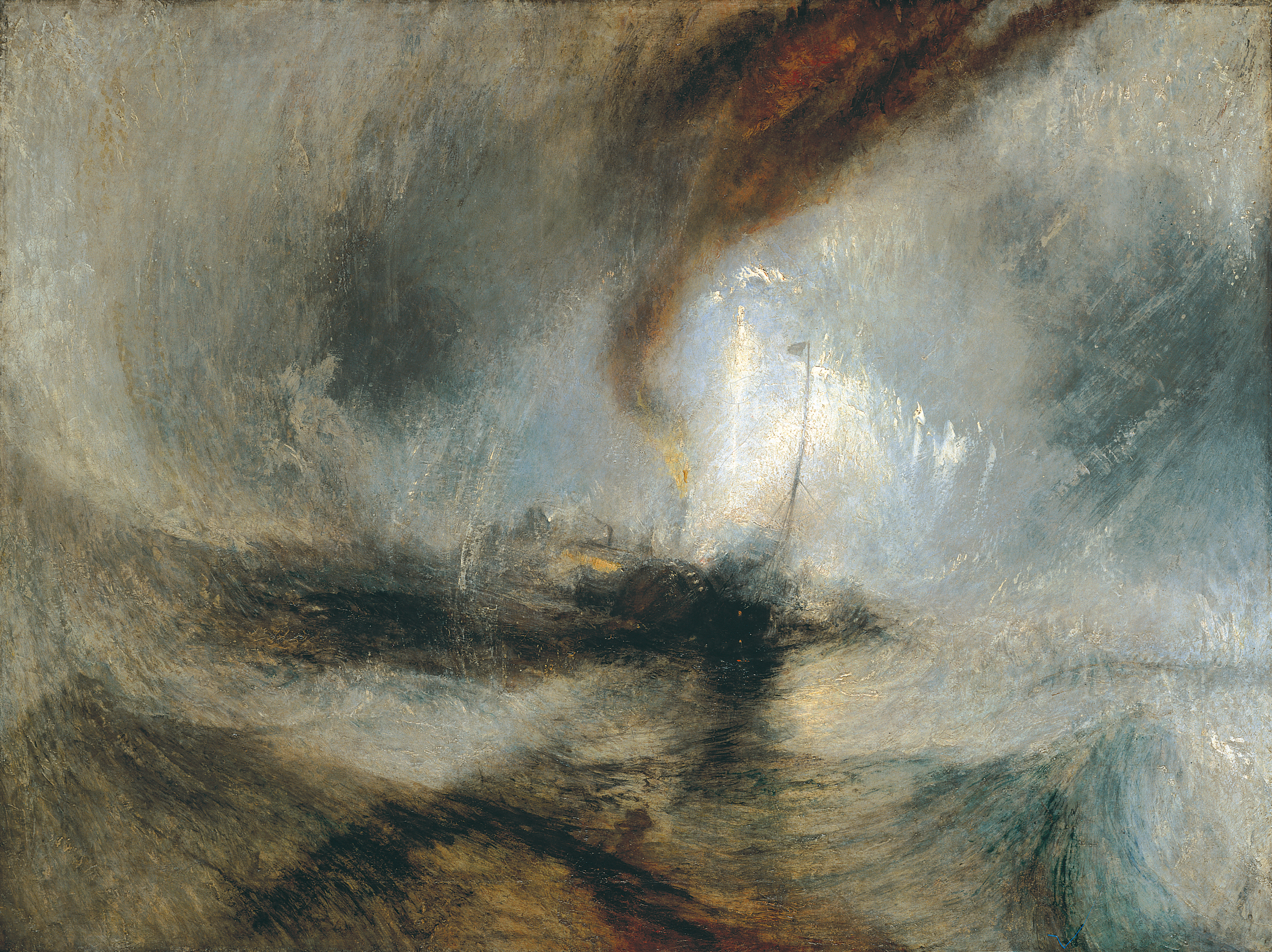
Joseph Mallord William Turner, Snow Storm – Steam-Boat off a Harbour’s Mouth Making Signals in Shallow Water, and going by the Lead. The Author was in this Storm on the Night the “Ariel” left Harwich), 1842, oil on canvas, 91 cm × 122 cm (Tate Britain, London)
A perfect storm
From the midst of a fierce snowstorm a 200-ton paddle steamer and its human cargo dips below a cresting wave as it battles to reach shore. Our view — which could be from another boat, perhaps, or even dry land — is blurred by a miasma of snow, wind and brine. Meanwhile the boat’s storm-agitated movements are evoked by a coil of black coal smoke spiraling into the sky, a mast bent by the gale, and a white vertical streak — a futile distress flare — which has been repeated several times as if its afterimage has burnt itself onto our retinas.
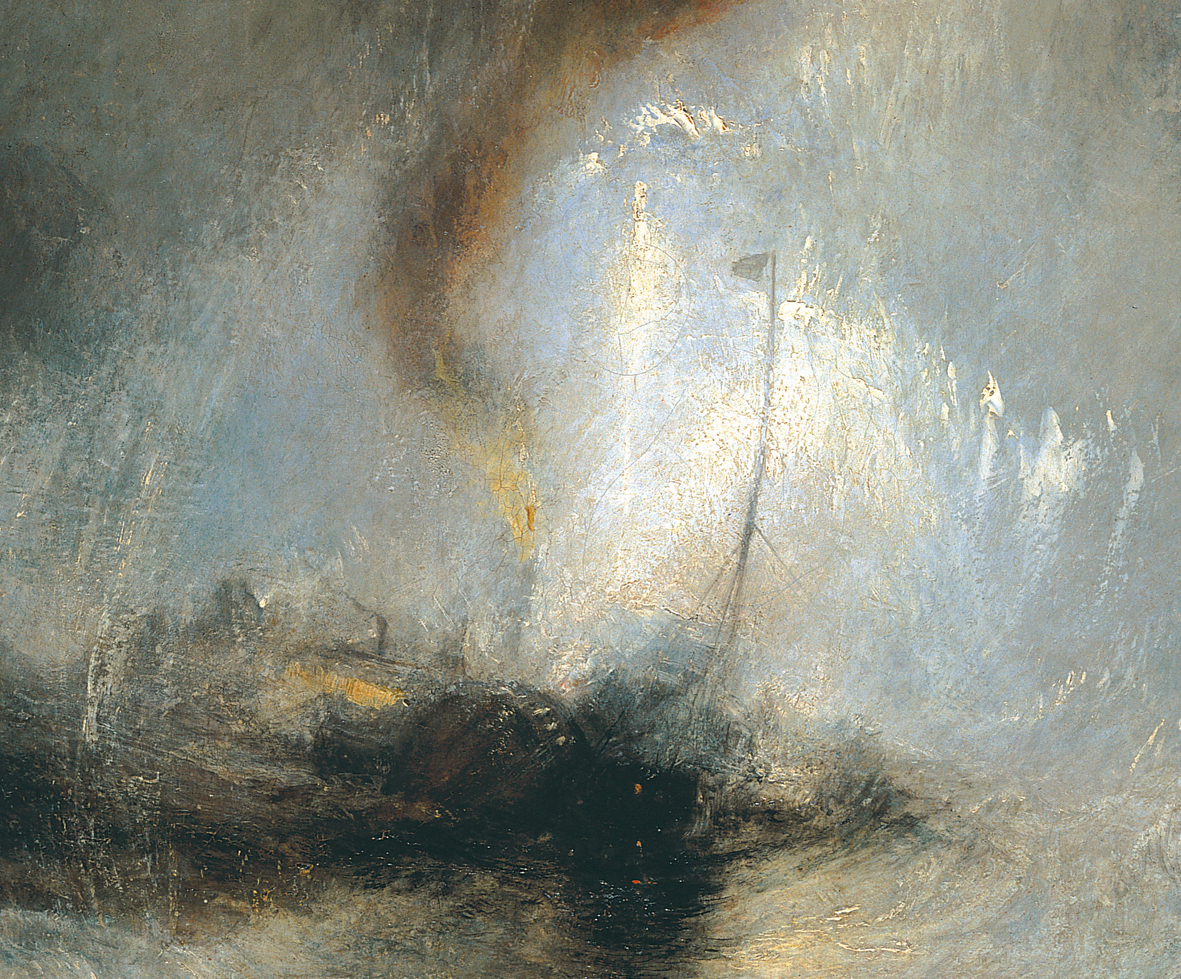
Joseph Mallord William Turner, detail, Snow Storm – Steam-Boat off a Harbour’s Mouth Making Signals in Shallow Water, and going by the Lead. The Author was in this Storm on the Night the “Ariel” left Harwich), 1842, oil on canvas, 91 cm × 122 cm (Tate Britain, London)
It is a startling, aggressive, thoroughly unconventional painting, and viewers at the British Royal Academy exhibition of 1842 — where it was first displayed — were bewildered and infuriated by its modern approach to a standard genre. We may empathize with the outrage if we compare Snow Storm to other nineteenth-century paintings of disasters at sea, like Théodore Gericault’s The Raft of the Medusa (1819).
In the Turner, clarity is exchanged for an expressive, almost abstract painterly execution. The painting’s visual structure is based around a swirling vortex rather than a stable pyramidal composition. It is also a virtually monochromatic image where sea and sky merge and spatial depth is hard to gauge. And rather than maintaining a consistent technique across the painting, Turner chopped and changed his approach — underpainting with oils mixed with turpentine to achieve a hazy watercolor effect, then using thick paint applied with a hog’s-hair brush and palette knife to generate rapid, gestural and broken slashes of color over the top. In other paintings he swiped, smeared and scratched at the surfaces he worked on, sometimes even spitting at them in an energetic frenzy. Turner’s violent techniques are well matched to the turbulent subject matter of this painting.
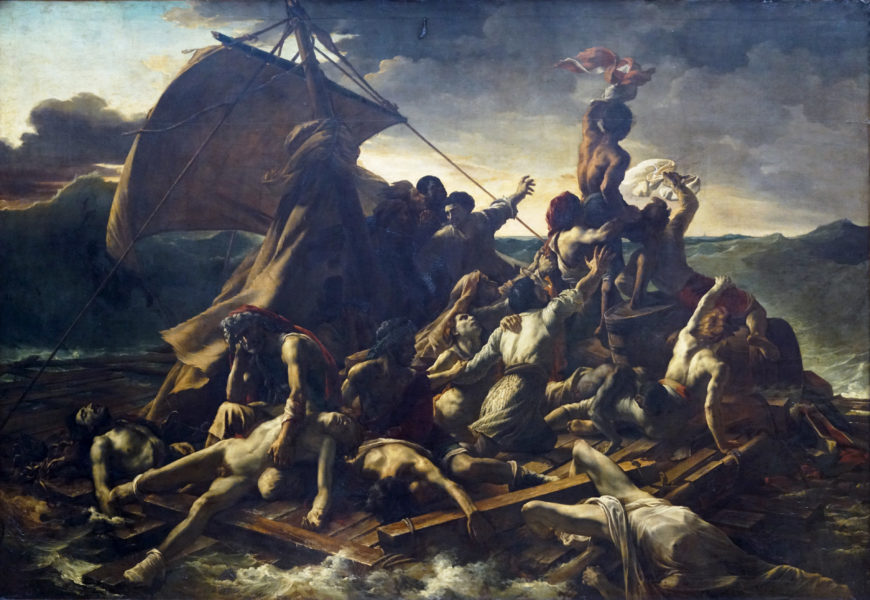
Théodore Géricault, Raft of the Medusa, 1818-19, oil on canvas, 4.91 x 7.16m (Musée du Louvre, Paris)
The relationship between title and image is also instructive. The painting’s name is extended and highly detailed, suggesting a record of a very particular maritime event, witnessed by the artist. Turner’s aim appears to be to show us that this is not merely artistic free-styling or an example of “art for art’s sake” (as Théophile Gautier had put it in 1835), rather it is a serious attempt to see nature truly and transcribe it afresh. At the same time its focus on a moment of high jeopardy in the face of nature’s wrath invites us to contemplate broader themes such as humanity’s struggle for rationality and sensory certainty in a world underwritten by chaos.
A painting of revolutions
Turner was knowledgeable about art history and throughout his career aimed to honor and emulate famous artists from the past such as Claude, Titian, and Rubens. At the same time, he also sought novel visual experiences, leading him to take an interest in contemporary events and modern technology. One such novelty were coal-powered steamboats, like the one depicted in Snow Storm, which came into widespread use in 1812, supplanting the use of sails and oars which had been used for the previous 4000 years of human history.
This change was just one that had defined the Industrial Revolution, a historical event which marked a pivotal change in society and humanity’s relationship with nature. One revelation was that nature was filled with energy, stored in matter such as coal and water, which could be unleashed and controlled to further human aspirations. Thus Snow Storm shows a modern appreciation of the landscape, in which all matter is surging with dynamic but untapped forces. This is not a triumph though: Turner has belittled the Industrial Revolution’s newest technology by subjecting it to the far greater might of nature.
The philosophy of fear
Like a disaster movie, Turner’s painting transforms a natural catastrophe — with death a near-certainty — into entertainment. “When danger or pain press too nearly, they are incapable of giving any delight, and are simply terrible” Edmund Burke had written in 1757, “but at certain distances, and with certain modifications, they may be, and they are, delightful.” [1] This morbid delight was given a name by Burke: the “sublime,” a condition of controlled terror, produced by a confrontation with nature’s overwhelming power. The reason that “sublime” art is appealing is probably because it contextualizes the audience’s own small stresses and anxieties by showing them the magnitude of the “bigger picture.” Turner was well aware of Burke’s theory of aesthetics and has become one of the most renowned advocates of the “sublime” in painting.

Joseph Mallord William Turner, Snow Storm – Steam-Boat off a Harbour’s Mouth Making Signals in Shallow Water, and going by the Lead. The Author was in this Storm on the Night the “Ariel” left Harwich), 1842, Oil on canvas, 91 cm × 122 cm (Tate Britain, London)
Turner later claimed in conversation that before painting Snow Storm he strapped himself to the mast of a ship and asked the owner to sail into a storm for four hours. This, and the claim to first-hand experience made in the title, urge us to regard Turner as a swashbuckling figure who fearlessly confronted the sublime in the name of art. However, as Barry Venning has pointed out, Turner was 65 in 1842, and according to historical records no ship called the Ariel sailed from Harwich at this time.
Fake though his story may have been, Turner’s self-mythologizing is still of interest, as it connects him to a broader cultural movement: Romanticism. This loose-knit intellectual phase in art, literature and music rebelled against Neoclassicism (which had been more focused on the intellect, collective responsibility, and controlled emotions) and instead put the focus on emotive responses, individual feelings and the overwhelming power of nature. Turner’s tall tale situates him as a prime exemplar of this self-oriented and expressive artistic tendency.
Legacy
This painting, like many others by Turner, split contemporary opinions. It certainly came under attack from many critics, one of whom called Snow Storm mere “soapsuds and whitewash” (i.e. dishwater and house-paint). On the other hand, English art critic John Ruskin called the painting “one of the very grandest statements of sea-motion, mist, and light, that has ever been put on canvas.” [2] Ruskin later famously called Turner “the father of modern art.”
A positive consensus about Turner’s reputation has grown and strengthened significantly since the mid-nineteenth century: the artist has been dedicated an entire separate section in Tate Britain known as the Clore Gallery. Britain’s most prestigious contemporary art prize — the “Turner Prize” is also named in his honor, and in February 2020 he was commemorated on the reverse of the new £20 banknote.

2020 £20 banknote honoring J.M.W. Turner
Turner’s bold, expressive techniques influenced French more than British art in the nineteenth century, with Claude Monet and the Impressionists especially admiring his pioneering and experimental techniques and representation of light. In the twentieth century, Abstract Expressionists like Mark Rothko, Jackson Pollock, and Barnett Newman were influenced directly or indirectly by Turner’s handling of paint and his engagement with “sublime” subject matter.


